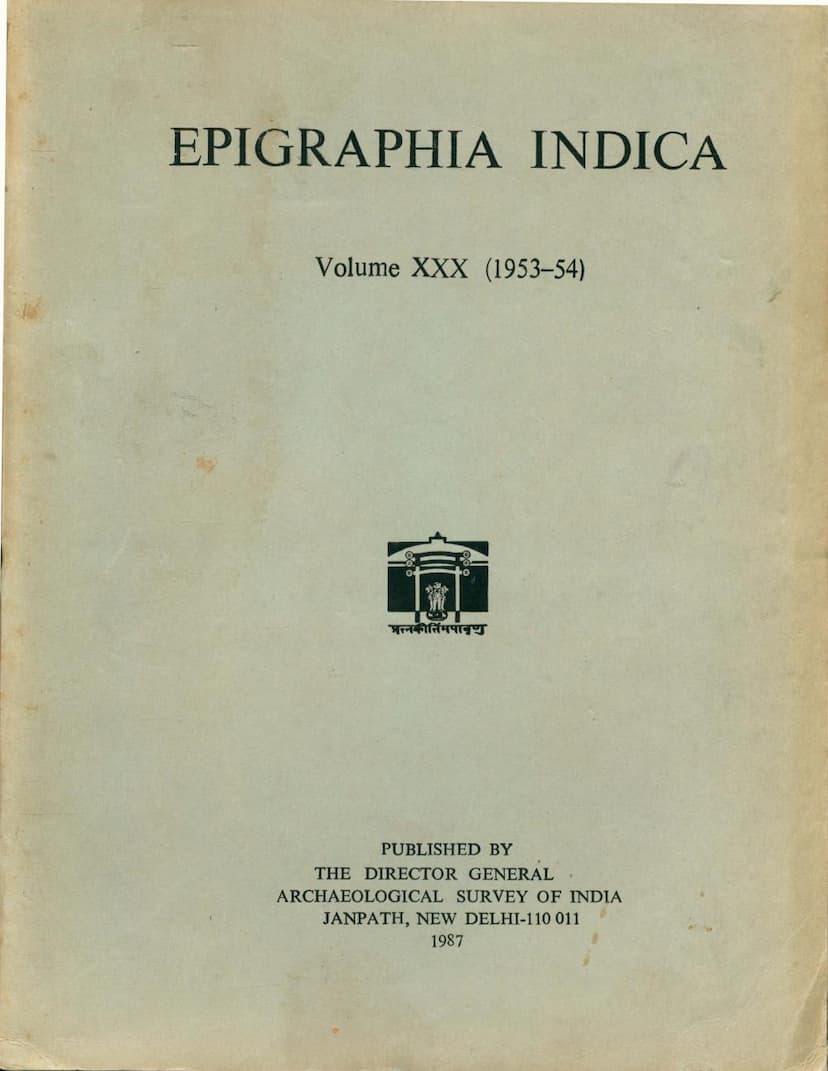Epigraphia Indica Vol 30
Added to library: September 1, 2025

Summary
Here's a comprehensive summary of the Jain content within Volume XXX of Epigraphia Indica, based on the provided text:
Epigraphia Indica, Volume XXX (1953-1954) - A Summary of its Jain Content
Volume XXX of Epigraphia Indica, published by the Archaeological Survey of India, presents a collection of ancient inscriptions, with several of them offering valuable insights into Jainism and its historical presence in India. While the volume covers a broad spectrum of historical and epigraphic material, specific inscriptions within it pertain to Jain religious practices, patronage, and the geographical spread of Jainism.
The following inscriptions and sections are particularly relevant to Jain content:
-
No. 23: Devaprayag Brahmi Inscriptions (Pages 133-194)
- Content: This section discusses a collection of Brahmi inscriptions discovered at Devaprayag, a significant pilgrimage site. While the inscriptions contain a variety of proper names, many of which are typical of the Gupta period, some names are noted for their association with the Jain religious traditions.
- Key Jain Relevance: The mention of names like Chaturvyūha is highlighted as particularly interesting. The text elaborates on the Vyuha concept in Jainism, explaining that the four Vyuhas are Vasudeva, Samkarshana, Pradyumna, and Aniruddha. The inscription, by including these names, indirectly points to the presence and possibly the practice of Jainism in the region. The philosophical ideas expressed in the invocatory stanzas are also noted for their potential connection to Jain texts, though a definitive link is not explicitly established in the provided summary of this section.
- Palaeographic Significance: The Brahmi script used in these inscriptions is described as dating from the 2nd to the 5th centuries AD, offering valuable data for understanding the evolution of ancient Indian scripts, which were also utilized for Jain inscriptions.
-
No. 31: Mathura Image Inscription of Vasudeva (Pages 182-194)
- Content: This inscription, found on a stone image of the Buddha at Mathura, discusses the Buddha and his followers. However, the analysis by D.C. Sircar touches upon broader religious practices of the era.
- Key Jain Relevance: While primarily discussing Buddhism and the broader Indian religious landscape of the Kushana age, the inscription's context is crucial for understanding the religious milieu in which Jainism also existed and flourished. The mention of Mahasanghika community and their teachers in the inscription highlights a sectarian division within Buddhism, providing a backdrop for the inter-sectarian interactions of the period, which would have included Jainism.
- Palaeographic and Historical Context: The Brahmi script and the dating of the inscription (64 or 67 of the Kanishka era, corresponding to 142 or 145 AD) place it within a period significant for the development and spread of various Indian religions, including Jainism.
-
General Observations on Jain Content:
- The volume, while primarily focused on epigraphy, includes inscriptions that indirectly shed light on the Jain tradition by providing context on the religious landscape of ancient and medieval India.
- The presence of Brahmi inscriptions and names that can be associated with Jain concepts (like Chaturvyuha in No. 23) indicates the geographical and temporal reach of Jainism.
- The discussions on the evolution of scripts (Brahmi, Nagari, Gaudiya) and dating eras (Saka, Vikrama, Gupta, Kalachuri, Anka) are fundamental to understanding the historical trajectory of all Indian religions, including Jainism.
In essence, Volume XXX of Epigraphia Indica, through inscriptions like the Devaprayag Brahmi inscriptions, provides historical context and occasional specific references that illuminate the presence and potential practices of Jainism during certain periods of Indian history, even if a significant portion of the volume focuses on other religious traditions. The epigraphical evidence within this volume contributes to a broader understanding of the religious pluralism of ancient and medieval India.